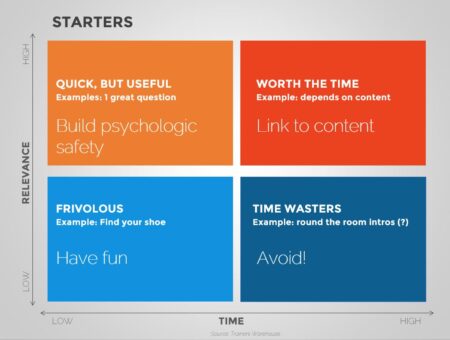Training Icebreakers that Make the Most of Every Minute
If you remember going to the Ringling Bros. and Barnum & Bailey Circus when you were a kid, you might recall arriving early to see clowns walking around the arena, greeting guests, and carrying their funny “walk-around” props (instant sight gags — visual images that make you chuckle). The clowns were onto something with their welcoming “come-in” ritual, and so are trainers when they greet you upon arrival and treat you to an “icebreaker.” I know. Many are skeptical of training icebreakers, but for trainers and participants alike, the first few minutes matter a lot. No matter what you call them, strong openers are essential to building trust, making connections, and setting the tone for effective learning experiences.
Meaningful and effective session starters require that you:
-
- Understand and Focus on your Goals
- Build Trust, Credibility, and Mutual Respect through Transparency
- Make Connections Between Content and Participants
- Choose the Right Activity
Let’s look at each in more detail.
1. Understand your Goal. Focus on your Purpose
Before you get too far in thinking about training icebreakers and starters, know what you hope to accomplish–not just for the opener, but for the entire learning event. Then, tie every exercise, presentation, and activity to these goals. For your opener, you might set your intention on building camaraderie, fostering new relationships, surfacing participants’ goals and concerns, or fun-for-the-sake-of-fun. Or, you might want to establish a foundation for the learning segment to come. Whatever it is, formulate your agenda around that goal.
2. Build Trust, Credibility, and Mutual Respect through Transparency
Set participants’ minds at ease by assuring them that their time won’t be wasted. That you are a capable facilitator from whom they can learn something useful, beyond what they already know. To quickly accomplish this, be transparent about your goals for both the training icebreaker and the learning outcomes. Always explain why you’re doing what you’re doing. Express your respect for the knowledge and expertise your participants bring to the table and encourage them to share their knowledge as well.
Using a Learners Bill of Rights or another list of ground rules, let participants know that they won’t be put on the spot, embarrassed, or stuck in an uncomfortable conversation. When trainers exhibit respect for their learners, they will be rewarded with reciprocal trust.
3. Make Connections Between Content and Participants
Perhaps the most primary purpose of intros, training icebreakers, and starters is to create mental links. You should make links between prior knowledge and new material; between the learners; and between the learners and facilitators. For instance, by asking learners what they already know about a topic, you are simultaneously helping them make their own mental connections, introducing core concepts, and giving the group an opportunity to connect with one another.
 4. Choose the Right Activity
4. Choose the Right Activity
Time-Relevance Matrix
Once you’re clear on your goals and have allayed the group’s fears, your challenge is selecting or formulating an experience that will serve these needs. You might like to think about your choices by plotting them within a matrix that takes into consideration the amount of time an activity will take and its relevance to your content.
Strive for the upper quadrants of the matrix where activities are appropriately tied to course content. If an activity is not relevant to your goals, consider limiting the time you allocate to the exercise or eliminating it altogether.
Picking Perfect Prompts
When it comes down to it, most training icebreakers fall into a handful of categories:
- Personal introductions
- Question/Answer Discussions
- Collaborative Problem Solving
- Collaborative Creativity
Of these 4 types of opening activities, Question/Answer formats are probably the most popular. You may want to use a ball populated with getting-to-know-you questions, like a Shaped By Our Past Thumball, or come up with a single question that gets to the heart of matters.
- Keep questions open-ended – stay away from yes/no questions or questions that require one-word answers
- Focus on experiences and interests – choose questions that draw from people’s experience, something they can answer easily
- Make the questions “safe” – be sensitive to prompts that might be awkward to answer
- Inspire dialogue and sharing – make sure there is no right or wrong answer
- Mix would and should questions – consider how the question’s framing will best promote positive dialogue
- Balance reflective and appreciative questions – include “appreciative” questions about goals and hopes.

TrainersEXCHANGE $399.95BUY NOW
Making it fun
After deciding on the questions or discussion prompts that might draw out an interesting exchange, trainers have many options for facilitating those conversations. For instance, rather than working their way around the room, they might ask groups to “pair and share” with a single partner, table talk, create triads, or roam the room. Trainers can also get creative with playful props including balls, answer boards, question decks, and image decks. Players can get creative with image decks by assembling one or more photos that tell a story, suggest a metaphor, or remind them of an experience or learning point.
Powerful Openers
No matter what icebreaker, discussion prompt, or activity you choose, be sure to explain why you’re playing with honesty and transparency. Show respect for your participants and their time, and give them an opportunity to make connections with the content and one another.
Finally, you might also want to reconsider the word “icebreaker.” Because training icebreakers can be loaded with negative associations, do yourself a favor and call them “starters,” “openers,” “appetizers,” or “come-in.” That way, your participants can start with a clean slate and an open mind.
READ MORE
Icebreakers to start a soft-skills workshop
The Perfect Prompt for any Session
Training Circus – Lessons from a Clown-Turned-Trainer
Icebreakers to start a Soft-Skills Session
Learning from Mistakes – Creating Safe Spaces for Learning

